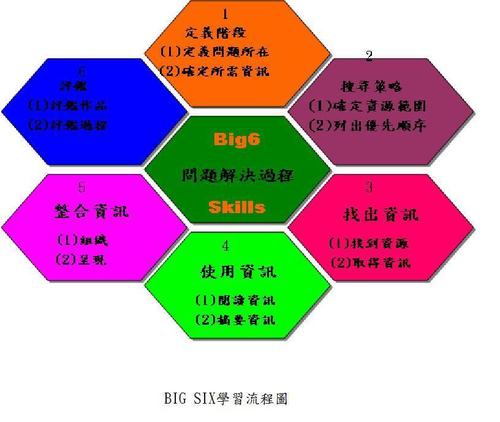v:* {behavior:url(#default#VML);}
o:* {behavior:url(#default#VML);}
p:* {behavior:url(#default#VML);}
.shape {behavior:url(#default#VML);}
v:textbox {display:none;}
v:* {behavior:url(#default#VML);}
o:* {behavior:url(#default#VML);}
p:* {behavior:url(#default#VML);}
.shape {behavior:url(#default#VML);}
v:textbox {display:none;}
v:* {behavior:url(#default#VML);}
o:* {behavior:url(#default#VML);}
w:* {behavior:url(#default#VML);}
.shape {behavior:url(#default#VML);}
/* Style Definitions */
table.MsoNormalTable
{mso-style-name:表格內文;
mso-tstyle-rowband-size:0;
mso-tstyle-colband-size:0;
mso-style-noshow:yes;
mso-style-parent:””;
mso-padding-alt:0cm 5.4pt 0cm 5.4pt;
mso-para-margin:0cm;
mso-para-margin-bottom:.0001pt;
mso-pagination:widow-orphan;
font-size:10.0pt;
font-family:”Times New Roman”;
mso-fareast-font-family:”Times New Roman”;
mso-ansi-language:#0400;
mso-fareast-language:#0400;
mso-bidi-language:#0400;}
What is Big Six ?
感謝同樂國小 林敏淑老師 教授
所謂Big6,資訊尋求的模式是取其六個步驟英文名稱的一個字母,
然後組合而成(B-I-G-S-I-X)
Be sure you understand the problem. Task Definition 確切地瞭解探究的問題——定義問題
Identify sources of information. Information Seeking 確定資訊資源的範圍——搜尋策略
Gather relevant information. Location & Access 獲取相關資訊——取得資訊
Select a solution. Use of Information 選擇一個解決方案——利用資訊
Integrate the ideas into a product. Synthesis 把觀點整合到作品中——整合資訊
eXamine the result. Evaluation 檢查結果——評鑑成果
